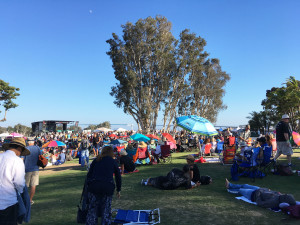
On a grassy field tucked between San Diego’s Seaport Village and Convention Center, hundreds of blues fans lined up beneath a cloudless sky, listening to the music of Big Jon Atkinson catch on the breeze as they waited for the San Diego Blues Festival to open. Stationed near the event entrance, Atkinson was the first of nine acts scheduled to perform at the sixth annual fest, a daylong celebration of music, community and summer’s end that would conclude with a performance by Grammy Award winners Los Lobos. There would be music, dancing, laughter and sunshine; there would be food, beer and plenty of free souvenirs distributed by the event sponsors. There would even be a tribute to American veterans delivered by Watermelon Slim in recognition of the 15th anniversary of September 11. But first, the crowds needed to get in.
By noon, Atkinson’s front gate performance had ended and the gates opened. Attendees carried lawn chairs, blankets, sunscreen and snacks over the grass, scoping out shady spots between the festival’s two large stages and assessing the area’s acoustics. Near the entrance, San Diego’s own Holla Pointe tuned up on the Baker Electric Solar Stage as the crowds continued filing in past vendors selling t-shirts, CDs, jewelry, beverages and festival food like soft pretzels and bratwurst. As Holla Point began playing, a navy ship pulled into the harbor as a subtle reminder of San Diego’s military roots. Fighter jets soared overhead in greeting as uniformed sailors stood at attention along the deck, floating past the community that was quickly developing onshore.
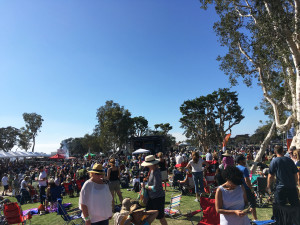
Every blues festival is an exercise in community, with its own set of rules and customs. Attendees know to bring sunscreen, cash for food and drink and a jacket for the evening (just in case). The wardrobe is predetermined (comfortable, often blues-themed clothing), napping during sets is permissible and strangers become friends when they see the name of their favorite band stretched across the shirt back of the person standing or sitting in front of them.
The sense of community is further felt in the support these festivals lend to local causes. The Big Muddy Blues Fest in St. Louis, Missouri encourages donations to the St. Louis Blues Society; the Doheny Blues Festival in Dana Point, California has in recent years supported educational programs associated with Doheny State Beach. For its annual event, the San Diego Blues Festival benefits the San Diego Food Bank and its North County chapter through collected proceeds and food donations. After dropping their donations by the entrance, attendees tuned in as the Holla Pointe launched a sunny eight-hour festival that included performances by Billy Watson and Junior Watson, Chris Cain, the Bey Paule Band featuring Wee Willie Walker, Watermelon Slim, Bobby Rush, Nikki Hill and Los Lobos.
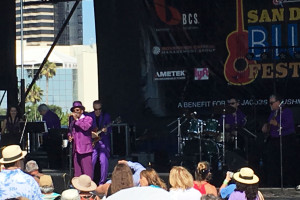
Big Jon Atkinson
Just outside the festival gates, Big Jon Atkinson and his band played for the early birds as they waited for the festival to open. Though Atkinson’s performance was best heard by those closest to his shady spot near the entrance, the late-morning breeze allowed the sound of his guitar to float down the line to listeners further away. It made for a fitting introduction to the event: waiting beside the bright blue bay, anticipation mounted as the blues of past generations echoed in Atkinson’s skilled playing.
The Holla Pointe
The San Diego-based band the Holla Pointe gave the festival its official launch at noon as attendees scooted in to stake out their seats. Established in late 2015, the Holla Pointe haven’t been together long, but founders Jimmy Zollo and Karl Cabbage have years of experience playing together, and it showed when they shared the stage. As Zollo sent blues riffs flying across the crowding field, Cabbage alternated between singing and playing fluidly, giving the sense that the duo’s backing band was much larger than it was in actuality.
Billy Watson and Junior Watson
First up on the Business Complete Solutions Stage were Billy Watson and Junior Watson. Both veterans of the West Coast blues scene, Billy and Junior are independently recognized for their animated stage presences, and they easily delivered. A whiz on the harmonica, Billy swung his arms onstage, dancing and singing to the upbeat blues style he champions as Junior kept pace on guitar, playing mostly blues but throwing in one memorable surf rock medley that fit the festival’s bayside location well.
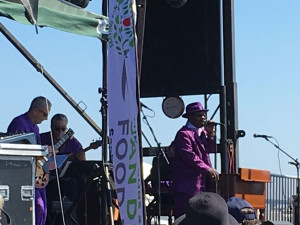
Chris Cain
The first striking thing about Chris Cain is his voice. Gruff and growling, it often draws comparisons to that of the late B.B. King. While he commanded the vocal and guitar duties throughout his set, he also jumped in on keys, keeping his performance upbeat and fluid. Some performers at festivals like these use the stage to present their skill at one instrument or another; others use it to show their flexibility. After a lifetime of studying the guitar and later delving into the piano, bass, clarinet and saxophone, Cain is a bluesman who practices his craft from multiple angles, throwing in jazzy improvisations when the mood fits.
Bey Paule Band with Wee Willie Walker
Bandleader Frank Bey and featured frontman Wee Willie Walker have both gathered multiple Blues Music Award nominations throughout their distinguished careers. Combining forces on the festival stage, Bey, Walker and their bandmates were all decked out in shiny purple suits, presenting themselves as a cohesive unit. The strong keys, horn and drum presence onstage gave the festival a triumphant push into the afternoon, with the field packed and people hopping between the stages to catch each performance. A blues veteran who cut his teeth at Memphis’ Goldwax Records in the 1960s, Walker had the look of one who’s as comfortable onstage as he’d be in his own living room, contributing to a fun, relaxed atmosphere that kept listeners nodding their heads and tapping their feet.
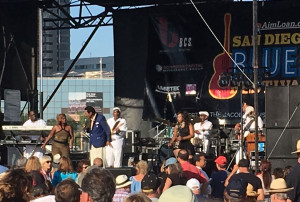
Watermelon Slim
The blues is a genre built on stories of life experiences, and listeners can’t get much better than Bill Homans (“Watermelon Slim”). In addition to serving in the United States Army during the Vietnam War, Slim has worked as a truck driver, a reporter, a collection agent, and held several other positions that provided him with the stories he now brings to his music. Upbeat and honest, Slim alternated between vocals and guitar for most of his performance, with one notable exception. As a tribute to the following day’s 15th anniversary of September 11 and to all American veterans, Slim paused mid-set to request that listeners remove their hats while he played “Taps” on his harmonica.
Bobby Rush
Blues Hall of Famer and Grammy nominee Bobby Rush defines the blues loosely. Supported by his band and a pair of backup singers who danced alongside Rush throughout his set, Rush bopped along to traditional blues riffs and Michael Jackson licks alike at the front of the stage. Though Rush’s vocals weren’t always clear to those at the back of the crowd, his harmonica playing punctuated choruses like that of “I Don’t Want Nobody Hanging Around” and other numbers that had the audience twirling and dancing.
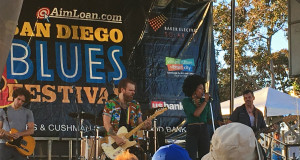
Nikki Hill
Nikki Hill has energy. It’s fun to watch performers like her: they dominate the stage, owning the space and fueling the crowd as they growl into the microphone. Hill’s voice was as powerful as her stage presence: at times resembling Tina Turner, Hill showed her vocal range throughout the set as her band supported. For her final number, Hill led the crowd through the verses of her original song “Oh My,” pumping listeners up as she danced and each band member signed off with a brief solo.
Los Lobos
As the sun set over the festival, some attendees pulled on jackets to watch Los Lobos’ closing performance up close–others danced the evening chill away as the Grammy Award winners covered blues favorites like the Temptations’ “Papa Was a Rollin’ Stone” and the Allman Brothers Band’s “One Way Out.” In addition to traditional rock ’n roll instruments like guitars, drums and vocals, Los Lobos pulled out an accordion, saxophone and keys, turning the evening into a giant lawn party. So varied was the band’s set and the makeup of the entire festival lineup that the band jokingly clarified, “This is a blues festival, right?” In a way, that question underscored the purpose of the San Diego Blues Festival: for one day, it provided a space where local fans could build a temporary community and celebrate the genre for the ways in which it has touched their lives.
-Meghan Roos
All photos by Meghan Roos


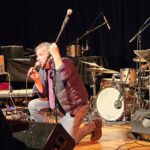
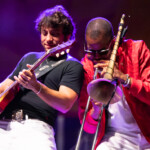

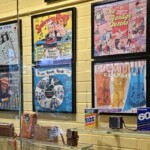

Be the first to comment!